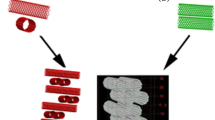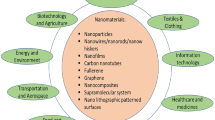Abstract
In this study, an effective model is proposed to predict the effect of nanoparticle agglomeration on the thermal conductivity of three-phase nanocomposites/polymers. In order to better describe this effect, the concept of agglomeration degree is introduced. The effect of particle volume fraction on thermal conductivity of composites is also studied by considering the interphase and agglomeration degree of particles. First, the relationship between agglomeration degree and particle volume fraction is discussed. Then, the effects of particle volume fraction, agglomeration degree and interphase thickness on thermal conductivity of composites are studied. The obtained results show that the agglomeration degree increases with increasing particle volume fraction. The thermal conductivity of composites increases first and then decreases with increasing particle agglomeration degree, and is also affected by the different thermal conductivity of particles and matrix, and the thickness of interphase.










Similar content being viewed by others
References
Zare, Y., Rhee, K.Y., Parkb, S.J.: A modeling methodology to investigate the effect of interfacial adhesion on the yield strength of MMT reinforced nanocomposites. J. Ind. Eng. Chem. 69, 331–337 (2019)
Ginzburg, V.V.: Recent Developments in Theory and Modeling of Polymer-Based Nanocomposites. Springer, Cham (2019)
Kochetov, R., Korobko, A.V., Andritsch, T., Morshuis, P.H.F., Picken, S.J., Smit, J.J.: Modelling of the thermal conductivity in polymer nanocomposites and the impact of the interface between filler and matrix. J. Phys. D Appl. Phys. 44(39), 395401 (2011)
Xie, S.H., Zhu, B.K., Li, J.B., Wei, X.Z., Xu, Z.K.: Preparation and properties of polyimide/aluminum nitride composites. Polym. Test. 23(7), 797–801 (2004)
Agarwal, S., Khan, M.M.K., Gupta, R.: Thermal conductivity of polymer nanocomposites made with carbon nanofibers. Polym. Eng. Sci. 48(12), 2474–2481 (2010)
Hu, J., Huang, Y., Zeng, X., Li, Q., Ren, L., Sun, R., Xu, J.B., Wong, C.P.: Polymer composite with enhanced thermal conductivity and mechanical strength through orientation manipulating of BN. Compos. Sci. Technol. 160, 127137 (2018)
Shen, D., Zhan, Z., Liu, Z., Cao, Y., Zhou, L., Liu, Y., Dai, W., Nishimura, K., Li, C., Lin, C.T., Jiang, N., Yu, J.: Enhanced thermal conductivity of epoxy composites filled with silicon carbide nanowires. Sci. Rep. 7(1), 2606 (2017)
Tessema, A., Zhao, D., Moll, J., Xu, S., Kidane, A.: Effect of filler loading, geometry, dispersion and temperature on thermal conductivity of polymer nanocomposites. Polym. Test. 57, 101–106 (2016)
Bian, L.C., Gao, M.: Nanomechanics model for properties of carbon nanotubes under a thermal environment. Acta Mech. 229(11), 4521–4538 (2018)
Wang, Y., Shan, J.W., Weng, G.J.: Percolation threshold and electrical conductivity of graphene-based nanocomposites with filler agglomeration and interfacial tunneling. J. Appl. Phys. 118(6), 065101 (2015)
Golbang, A., Famili, M.H.N., Shirvan, M.M.M.: A method for quantitative characterization of agglomeration degree in nanocomposites. Compos. Sci. Technol. 145, 181–186 (2017)
Zeinedini, A., Shokrieh, M.M., Ebrahimi, A.: The effect of agglomeration on the fracture toughness of CNTs-reinforced nanocomposites. Theor. Appl. Fract. Mech. 94, 84–94 (2018)
Dorigato, A., Pegoretti, A., Dzenis, Y.: Filler aggregation as a reinforcement mechanism in polymer; nanocomposites. Mech. Mater. 61(8), 79–90 (2013)
Jahanmard, P., Shojaei, A.: Mechanical properties and structure of solvent processed novolac resin/layered silicate: development of interphase region. RSC Adv. 5, 80875–80883 (2015)
Cheng, Y., Bian, L., Wang, Y.Y., Taheri, F.: Influences of reinforcing particle and interface bonding strength on material properties of Mg/nano-particle composites. Int. J. Solids Struct. 51(18), 3168–3176 (2014)
Zare, Y., Garmabi, H., Rhee, K.Y.: Prediction of complex modulus in phase-separated poly (lactic acid)/poly (ethylene oxide)/carbon nanotubes nanocomposites. Polym. Test. 66, 189–194 (2018)
Kochetov, R., Korobko, A.V., Andritsch, T., Morshuis, P.H.F., Picken, S.J., Smit, J.J.: Three-phase Lewis–Nielsen model for the thermal conductivity of polymer nanocomposites. In: 2011 Annual Report Conference on Electrical Insulation and Dielectric Phenomena, IEEE (2012)
Qiao, R., Brinson, L.C.: Simulation of interphase percolation and gradients in polymer nanocomposites. Compos. Sci. Technol. 69(3–4), 491–499 (2009)
Sevostianov, I., Kachanov, M.: Effect of interphase layers on the overall elastic and conductive properties of matrix composites. Applications to nanosize inclusion. Int. J. Solids Struct. 44(3–4), 1304–1315 (2007)
Nan, C.W., Birringer, R., Clarke, D.R., Gleiter, H.: Effective thermal conductivity of particulate composites with interfacial thermal resistance. J. Appl. Phys. 81(10), 6692 (1997)
Minnich, A., Chen, G.: Modified effective medium formulation for the thermal conductivity of nanocomposites. Appl. Phys. Lett. 91(7), 073105 (2007)
Machrafi, H., Lebon, G., Iorio, C.S.: Effect of volume-fraction dependent agglomeration of nanoparticles on the thermal conductivity of nanocomposites: applications to epoxy resins, filled by SiO2, AlN and MgO nanoparticles. Compos. Sci. Technol. 130, 78–87 (2016)
Wemhoff, A.P., Webb, A.J.: Investigation of nanoparticle agglomeration on the effective thermal conductivity of a composite material. Int. J. Heat Mass Transf. 97, 432–438 (2016)
Eshelby, J.D.: The determination of the elastic field of an ellipsoidal inclusion, and related problems. Proc. A 241(1226), 376–396 (1957)
Mori, T., Tanaka, K.: Average stress in matrix and average elastic energy of materials with misfitting inclusions. Acta Metall. 21(5), 571–574 (1973)
Van Tung, H., Trang, L.T.N.: Imperfection and tangential edge constraint sensitivities of thermomechanical nonlinear response of pressure-loaded carbon nanotube-reinforced composite cylindrical panels. Acta Mech. 229(5), 1949–1969 (2018)
Lee, J.K.: Prediction of thermal conductivities of laminated composites using penny-shaped fillers. J. Mech. Sci. Technol. 22(12), 2481–2488 (2008)
Chen, H., Witharana, S., Jin, Y., Kim, C., Ding, Y.: Predicting thermal conductivity of liquid suspensions of nanoparticles (nanofluids) based on rheology. China Particuol. 7(2), 151–157 (2009)
Prasher, R., Evans, W., Meakin, P., Fish, J., Phelan, P., Kebinski, P.: Effect of aggregation on thermal conduction in colloidal nanofluids. Appl. Phys. Lett. 89(14), 143119 (2006)
Hui, P.M., Zhang, X., Markworth, A.J., Stroud, D.: Thermal conductivity of graded composites: numerical simulations and an effective medium approximation. J. Mater. Sci. 34(22), 5497–5503 (1999)
Deng, X., Huang, Z., Wang, W., Rajesh, N.D.: Investigation of nanoparticle agglomerates properties using Monte Carlo simulations. Adv. Powder Technol. 27, 1971–1979 (2016)
Downing, T.D., Kumar, R., Cross, W.M., Kjerengtroen, L., Kellar, J.J.: Determining the interphase thickness and properties in polymer matrix composites using phase imaging atomic force microscopy and nanoindentation. J. Adhes. Sci. Technol. 14(14), 1801–1812 (2000)
Behrang, A., Grmela, M., Dubois, C., Turenne, S., Lafleur, P.G.: Influence of particle-matrix interface, temperature, and agglomeration on heat conduction in dispersions. J. Appl. Phys. 114(1), 508 (2013)
Finney, E.E., Shields, S.P., Buhro, W.E., Finke, R.G.: Gold nanocluster agglomeration kinetic studies: evidence for parallel bimolecular plus autocatalytic agglomeration pathways as a mechanism-based alternative to an avrami-based analysis. Chem. Mater. 24(10), 1718–1725 (2012)
Funding
This study was funded by the Science Research Foundation of Hebei Advanced Institutes (ZD2017075).
Author information
Authors and Affiliations
Corresponding author
Ethics declarations
Conflict of interest
The authors declare that they have no potential conflicts of interest.
Additional information
Publisher's Note
Springer Nature remains neutral with regard to jurisdictional claims in published maps and institutional affiliations.
Appendix: Aggregative growth
Appendix: Aggregative growth
This appendix qualitatively explains why Eq. (26) can be set to power-law form. First, a simple kinetic mechanism is considered, which is called “aggregative growth” [34]. Accordingly, the agglomeration kinetics is controlled by the following equation:
where P stands for the nanoparticles and A for the agglomerate. The “nucleation rate,” defined as the rate of the first agglomerate formed from the initial nanoparticles, is given by
with \(k_\mathrm{n} \) the nucleation rate constant and square brackets indicating the molar concentration. The term \(\frac{\mathrm{d}\left[ P \right] }{\mathrm{d}t}\) in (A2) stands for the consumption of P due to nucleation only. The “agglomerative growth rate” is given by:
where \(k_\mathrm{g} \) is the rate constant of agglomerate growth. The term \(\frac{\mathrm{d}\left[ P \right] }{\mathrm{d}t}\) in (A3) stands for the consumption of P due to agglomerate growth only. From (A1):
It follows from (A4) that \(\frac{\mathrm{d}\left[ A \right] }{\mathrm{d}t}=-\frac{1}{2}\frac{\mathrm{d}\left[ P \right] }{\mathrm{d}t}\), so that the total rate law for the agglomeration mechanism is given by
Making use of the initial conditions \(\left. {\left[ A \right] } \right| _{t=0} =\left[ A \right] _{0} =0\), \(\left. {\left[ P \right] } \right| _{t=0} =\left[ P \right] _{0} \) and relation (A4), the solution of Eq. (A5) is given by
When \(t\rightarrow \infty _{\mathrm { ,}}\left[ A \right] _{\infty } =\frac{\left[ P \right] _{0} }{2}\). This indicates that the concentration of agglomerates may be up to half of the initial particle concentration. It can also be seen from the formula that the final concentration of aggregates depends on the initial concentration of nanoparticles. This shows that the size of the agglomerate (and the degree of agglomeration) is a function of the initial volume fraction of nanoparticles. According to the law of proportion, the number of nanoparticles in agglomerates can be determined at a given time:
with \(N_{\infty }\) the final number of nanoparticles in the agglomerate. However, the limit \(t\rightarrow \infty \) is not realistic and (A7) is not valuable at this value. Therefore, a middle value \(N_{\mathrm{int}}\) is taken here:
where \(\left[ A \right] ^{*}<\frac{\left[ P \right] _{0} }{2}\). The relation between the agglomerate size D and the number of nanoparticles in the agglomerate zone can be assumed as follows:
where C is a constant composed out of material constants and geometric data, and b is the fractal index. Coupling Eqs. (A8) and (A9) results in
where \(\left[ P \right] _{0} \propto f_\mathrm{p}\). Therefore, Eq. (26) can be set to power-law form.
Rights and permissions
About this article
Cite this article
Bian, L., Liu, C. An effective model for the thermal conductivity of nanoparticle composites/polymers. Acta Mech 231, 1639–1654 (2020). https://doi.org/10.1007/s00707-019-02610-9
Received:
Revised:
Published:
Issue Date:
DOI: https://doi.org/10.1007/s00707-019-02610-9




